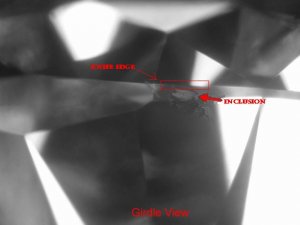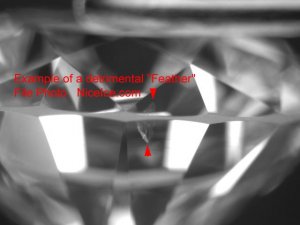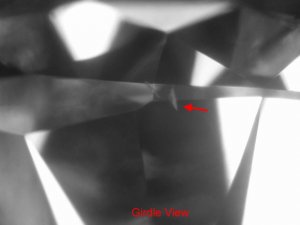You are using an out of date browser. It may not display this or other websites correctly.
You should upgrade or use an alternative browser.
You should upgrade or use an alternative browser.
Cavity
- Thread starter pyramid
- Start date
- Status
- Not open for further replies. Please create a new topic or request for this thread to be opened.
belle
Super_Ideal_Rock
- Joined
- Nov 19, 2004
- Messages
- 10,285
obviously, not an expert here, but i''ll throw out my .02 and say that the particular inclusion wouldn''t effect the measured girdle width because there are obviously thicker (stage left) and thinner (stage right) portions of the girdle already.
since the thickest and thinnest portions are what are reported and this inclusion falls (by size) in between those extremes, it won''t effect the overall measurement.
since the thickest and thinnest portions are what are reported and this inclusion falls (by size) in between those extremes, it won''t effect the overall measurement.
thank you for your reply Belle.
C Smith I found this on the GIA edu site and it seems to say a cavity can affect girdle width
An extra facet, natural, chip, cavity or indented natural
located on the crown or pavilion at the girdle edge can
narrow the girdle at this location.In these cases,the remaining
area is considered in the thickness assessment even
when the feature is located at a “hill” position (see figures
10 and 11). If a “knife-edge” is created, the girdle thickness
is reported as extremely thin. If a chip, cavity or
indented natural breaks through the girdle onto the crown
and pavilion, the effect on girdle thickness is not considered
in the assessment (see figure 11).All of these characteristics
are accounted for in the diamond’s clarity grade.
C Smith I found this on the GIA edu site and it seems to say a cavity can affect girdle width
An extra facet, natural, chip, cavity or indented natural
located on the crown or pavilion at the girdle edge can
narrow the girdle at this location.In these cases,the remaining
area is considered in the thickness assessment even
when the feature is located at a “hill” position (see figures
10 and 11). If a “knife-edge” is created, the girdle thickness
is reported as extremely thin. If a chip, cavity or
indented natural breaks through the girdle onto the crown
and pavilion, the effect on girdle thickness is not considered
in the assessment (see figure 11).All of these characteristics
are accounted for in the diamond’s clarity grade.
Date: 11/23/2006 11:33:26 AM
Author: Pyramid
thank you for your reply Belle.
C Smith I found this on the GIA edu site and it seems to say a cavity can affect girdle width
An extra facet, natural, chip, cavity or indented natural
located on the crown or pavilion at the girdle edge can
narrow the girdle at this location.In these cases,the remaining
area is considered in the thickness assessment even
when the feature is located at a “hill” position (see figures
10 and 11). If a “knife-edge” is created, the girdle thickness
is reported as extremely thin. If a chip, cavity or
indented natural breaks through the girdle onto the crown
and pavilion, the effect on girdle thickness is not considered
in the assessment (see figure 11).All of these characteristics
are accounted for in the diamond’s clarity grade.
I''m interested to see what other gemologist have to say about this. I don''t think I''d classify that cavity in your image as leaving a knife edge or making an otherwise normal girdle rate extremely thin however. I''d note it on the plot and in the notes and the girdle would rate as if that blemish/inclusion were not there. The ISG does not rate typical naturals,chips and cavities against girdle thickness. They are considered clarity characteristics and are noted thus

belle
Super_Ideal_Rock
- Joined
- Nov 19, 2004
- Messages
- 10,285
i got 'feather' in my head because of the first pic and didn't realize that the second pic was of a cavity. a cavity is a piece of the diamond that is 'missing'. obviously, if you have a piece of the girdle missing and the remaining portion (above or below) is thinner than normally acceptable, it will effect the width.
i think my (very lame) attempt at making the 'cavity' more pronounced and the area of the remaining girdle obviously thin, you can see how such an inclusion would effect the measurement.

i think my (very lame) attempt at making the 'cavity' more pronounced and the area of the remaining girdle obviously thin, you can see how such an inclusion would effect the measurement.

I think this is a stone by stone call that CANNOT be generalized.
I have seen examples both ways..... i.e. changing the girdle measurement from ex thin to ex thick due to naturals/extra facets which are extreme. I''ve also noticed this with severely indented naturals too.
An additional issue is how uniform and straight the girdle is. Most gem lab reports don''t graphically show a wavy girdle.
Rockdoc
I have seen examples both ways..... i.e. changing the girdle measurement from ex thin to ex thick due to naturals/extra facets which are extreme. I''ve also noticed this with severely indented naturals too.
An additional issue is how uniform and straight the girdle is. Most gem lab reports don''t graphically show a wavy girdle.
Rockdoc
The http address to the site which shows some photos is:
http://www.diamondcut.gia.edu/pdf/culet_girdle_assessment_0106.pdf
http://www.diamondcut.gia.edu/pdf/culet_girdle_assessment_0106.pdf
Date: 11/23/2006 1:13:28 PM
Author: RockDoc
I think this is a stone by stone call that CANNOT be generalized.
I have seen examples both ways..... i.e. changing the girdle measurement from ex thin to ex thick due to naturals/extra facets which are extreme. I''ve also noticed this with severely indented naturals too.
An additional issue is how uniform and straight the girdle is. Most gem lab reports don''t graphically show a wavy girdle.
Rockdoc
Rockdoc how could a severely indented natural change the girdle measurement to ex thick? It would be indented.
How can you tell when a natural is on the edge of the girdle whether it is an inclined natural or an indented natural anyway? According to the site I mentioned about if it breaks onto the crown it is an indented natural, but Kenny''s stone (which experts think is not a natural) was deemed to maybe have a natural and it was on the edge of the girdle and onto the crown but looked in no way indented.
After reading some old posts in which pictures were posted of inclined natural and indented natural I now realise the difference is the digging into the stone part. I don't know why but a picture of an inclined one I had looked at previously where a part of girdle was straight above the incline seemed to look wrongly as though the inclined part was digging into the stone. I think this is the difference between seeing things like this on a computer screen as compared to seeing it in a three dimensional view with the eyes.
- Status
- Not open for further replies. Please create a new topic or request for this thread to be opened.
Share:
Past, Present, Future: The Meaning of Three-Stone Engagement Rings
Past, Present, Future: The Meaning of Three-Stone Engagement Rings - 04/14









300x240.png)